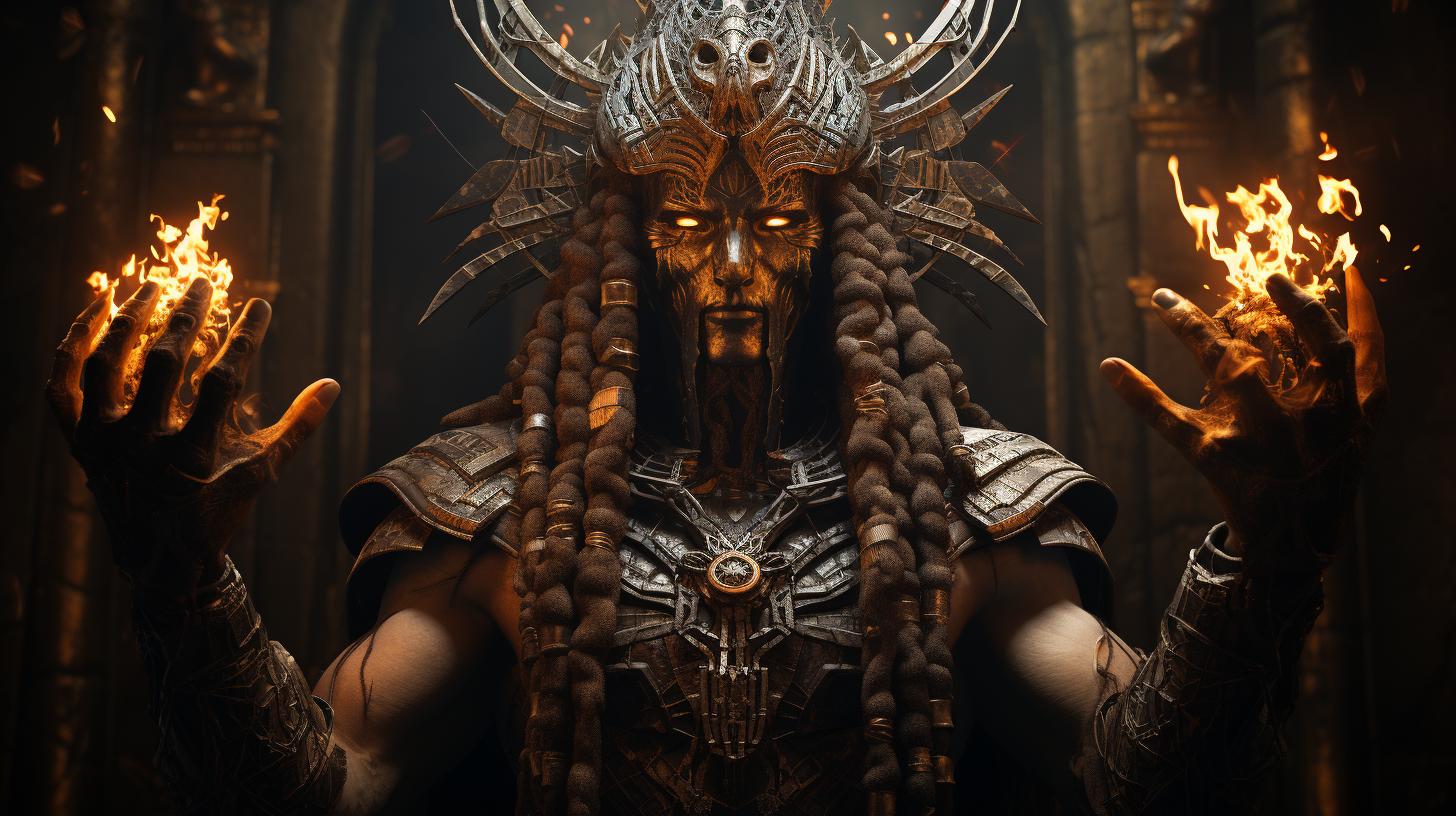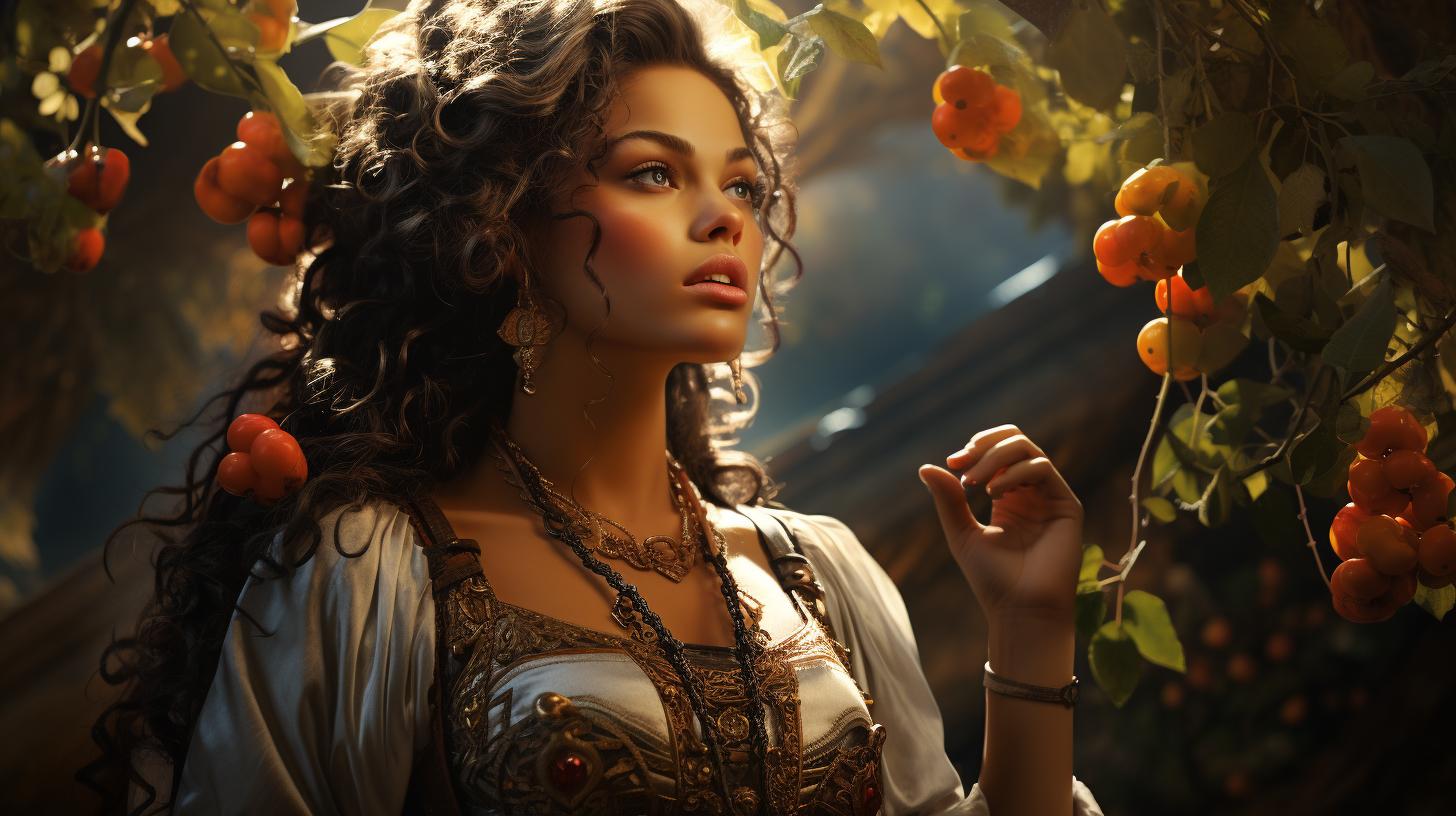Tanit: The Enigmatic Goddess of Carthage and Ibiza

Goddess Tanit, the ancient deity of Carthage and Ibiza, holds immense significance in history. As the primary deity of Carthage, Tanit was worshipped alongside her consort, Baal Hammon, and revered as the celestial goddess of war, motherhood, and fertility.
Known as the Carthaginian goddess, her worship extended throughout the Western Mediterranean, leaving its mark in regions like Sicily, North Africa, and the Iberian Peninsula. Associated with the Phoenician goddess Astarte, Tanit’s influence reached far and wide, symbolized by the trapezoid or triangular shape often interpreted as a woman raising her hands, a representation of the Tanit goddess symbol, and her depiction as a lion-mounted or lion-headed figure.
The Origin of Goddess Tanit
Goddess Tanit, with her rich history and vast influence, is believed to have originated in the ancient city of Carthage. Her roots can be traced back to the Phoenician goddess Astarte, as their names were closely associated, revealing the depth of Tanit meaning in the pantheon of gods and goddesses.
Tanit emerged as a prominent deity, embodying various aspects such as war, fertility, and motherhood, with connections to the sea and the crescent moon, which further enriched her symbolism. The worship of Tanit gained momentum in Carthage, where she became revered as the primary deity, sharing cult practices with her consort, Baal Hammon, and establishing herself as a significant figure in the Punic religion.
The unique blend of Phoenician and indigenous Carthaginian beliefs contributed to the distinct characteristics attributed to Tanit, including her association with palm trees, animals, and the crescent moon, symbolizing her comprehensive divine powers.
As her worship reached beyond the borders of Carthage, Tanit’s influence expanded, spreading to other regions of the Mediterranean, including the island of Ibiza.
The Phoenicians played a significant role in disseminating the cult of Tanit to different territories, leaving an indelible mark on religious practices and helping to spread the Tanit symbol throughout the ancient world.
Through the representation of Tanit as a celestial goddess of war and symbol of fertility, her influence grew, captivating the hearts of worshippers and adherents of various cultures and civilizations.
The Tanit-Astarte connection, in particular, highlights the layered nature of the deity’s origins and the synthesis of diverse religious traditions.
- Tanit’s roots can be traced back to the Phoenician goddess Astarte.
- She emerged as a significant deity in Carthage, embodying multiple facets such as war, fertility, and motherhood.
- Tanit’s worship extended beyond Carthage, reaching regions across the Mediterranean.
- The Phoenicians played a crucial role in spreading the cult of Tanit to various territories.
- Tanit’s representation as a celestial goddess of war and symbol of fertility captivated worshippers of diverse cultures.
The exploration of Tanit’s origin provides a foundation for understanding her significance and the enduring legacy she holds in ancient and modern societies alike.
Exploring the Influence of Tanit in Carthage
The ancient city of Carthage held Tanit, the goddess of tremendous significance. Her worship and beliefs permeated every aspect of life in Carthaginian society. Let’s delve into the various facets of her influence in Carthage.
Worship and Beliefs Surrounding Tanit
Worship of Tanit was central to the religious practices in Carthage. She was revered as a celestial goddess, often associated with fertility, motherhood, and war. Carthaginians believed that Tanit held immense power and played a crucial role in their prosperity and protection, embodying the mind-body connection through her nurturing and protective aspects.
Tanit and Baal Hammon: Consorts in Worship
Baal Hammon, considered the chief god in Carthage, shared divine worship with Tanit. As consorts, they formed a powerfully symbiotic relationship, embodying the divine feminine and masculine energies. Their combined influence reinforced the divine protection, fertility, and prosperity sought by the Carthaginians.
Ceremonies dedicated to both Tanit and Baal Hammon exemplified their interconnected roles in the Carthaginian pantheon and the enduring legacy of their worship in modern-day explorations of ancient deities.
Tanit as the Mother Goddess and Symbol of Fertility
One of Tanit’s prominent aspects was her association with motherhood and fertility. Carthaginians venerated her as the ultimate mother goddess, representing creation, abundance, and growth. Tanit played a crucial role in ensuring safe childbirth, nourishment, and the advancement of agricultural activities in Carthage, reflecting her status as the Carthaginian god of plant fertility.
Her symbolism as a provider of fertility and prosperity solidified her importance in the lives of Carthaginians, making her an enduring figure of worship and reverence.
Unveiling Tanit’s Presence in Ibiza and Beyond
Unveiling Tanit’s presence beyond Carthage, we explore the spread of her worship to the vast Mediterranean region.
Her influence reached far and wide, leaving traces of her divine presence in various cultures and civilizations, including the ancient temple sites dedicated to her worship.
Spread of Tanit’s Worship to the Mediterranean
As the main deity of Carthage, Tanit’s worship extended beyond the city’s borders, reaching neighboring regions and islands.
Her influence can be traced across Sicily, Malta, northern Africa, and even as far as Gades in North Africa. The powerful and widespread network of Phoenician traders facilitated the spread of her cult, establishing connections with the local traditions and integrating Tanit into their pantheons.
Tanit, revered not only as a Phoenician goddess but also as a symbol of love and fertility, became a prominent figure in these areas.
Through the Phoenician trading networks, the cult of Tanit found its way into new lands, captivating the hearts and minds of diverse communities throughout the Mediterranean.
Her significance grew as her worship spread, establishing her as a prominent goddess in the collective religious consciousness of the region. This expansion illustrates the powerful and enduring nature of her worship, which might have included rituals celebrating fertility, motherhood, and the cycles of nature.
Tanit’s Association with Astarte and Phoenician Deities
Both goddesses exhibit attributes of fertility and warfare, underscoring their complex roles in ancient societies.
Furthermore, Tanit’s connection to other Phoenician deities, such as Baal Hammon, illustrates the complexity of her religious significance.
The consortship of Tanit and Baal Hammon in worship symbolized the divine union of feminine and masculine energies, further enhancing their divine influence in the ancient world. This connection underscores the interwoven nature of deities within the Phoenician pantheon and their roles in the cosmic order.
The Symbolism of Tanit: Triangles, Lions, and More
Tanit, the revered goddess of ancient Carthage and Ibiza, is associated with various powerful symbols that reflect her significance and influence. These symbols serve as important representations of Tanit’s divine attributes and emphasize her multifaceted nature.
The Trapezoid: A Profound Representation
One of the primary symbols associated with Tanit is the trapezoid or triangular shape, often likened to the horizontal arm of a balance. It is often interpreted as a woman lifting her hands in prayer or as a manifestation of Tanit herself.
This symbolism, evoking the crescent moon and the connection with the divine, highlights Tanit’s celestial status and her connection to the divine realm.
The Enigmatic Lion: Strength and Majesty
Tanit’s association with lions further adds to her illustrious symbolism. She is frequently depicted riding or accompanied by lions, showcasing her power, strength, and regal nature. The lion serves as a symbol of royalty, courage, and protection, underscoring Tanit’s role as a guardian and mother goddess.
Her warrior quality is often depicted alongside these majestic animals, signifying her protective and nurturing aspects.
Fertility and Nurturing: Depictions of Motherhood
An integral aspect of Tanit’s symbolism is her representation as a nurturing mother figure. Depicted with a lioness head or riding on a lion, Tanit embodies the qualities of fertility, abundance, and motherhood.
Her presence signifies the life-giving forces of nature and the cycles of creation, emphasizing her role as a symbol of fertility and prosperity. This aspect of her nature is closely connected with the cycles of the moon and the natural world, symbolizing the enduring connection between the goddess, fertility, and the cosmos.
Mystical Connotations: Moon and Celestial Imagery
Another element of Tanit’s symbolism lies in her association with celestial and lunar imagery. As the goddess of the sky, she is often depicted with lunar motifs and referred to as the “celestial goddess.”
This connection to the moon symbolizes Tanit’s influence over the cycles of life, the rhythm of nature, and the cosmic forces that govern the universe. The crescent moon and the palm tree often found in depictions of Tanit symbolize her dominion over the heavens and the earth, highlighting her role as a bridge between the celestial and terrestrial realms.
Tanit’s symbolism, characterized by the trapezoid, lions, motherhood, and celestial imagery, offers a glimpse into her divine attributes and the reverence she commanded in ancient cultures. These symbols not only reinforce her connection to war, fertility, and motherhood but also reflect the enduring legacy of Tanit and her powerful influence throughout the ages.
Controversy Surrounding Tanit: Evidence of Child Sacrifice?
Controversy has long surrounded the worship of Tanit, with some scholars suggesting the existence of child sacrifice rituals associated with her cult. The practices in question were discovered in ancient Carthage and are commonly referred to as the Tophet rituals.
The Tophet Rituals: Controversial Practices in Ancient Carthage
The Tophet was an area in Carthage where numerous small burial sites were found containing the remains of children and animals. These discoveries have fueled speculation that child sacrifice was indeed a part of Tanit’s religious ceremonies.
The rituals involved placing young children or animals into specially constructed votive furnaces, known as stelae. These stelae were adorned with symbols associated with Tanit, possibly indicating a connection between the sacrificial practices and the goddess herself.
While the exact reasons behind these rituals remain unclear, theories suggest that they may have served as offerings to ensure fertility, protection, or seek divine favor in times of distress.
Examining the Theories and Evidence
Researchers, historians, and archaeologists have extensively examined the evidence surrounding the Tophet rituals to understand the true nature and intent behind these practices.
Various theories have been put forward to explain the child sacrifice rituals. Some propose that they were purely symbolic, while others argue for a more literal interpretation involving actual sacrifices. It is important to note that the evidence is still subject to interpretation, and no definitive conclusions have been reached.
Archaeological findings, including the presence of animal remains and inscriptions referencing Tanit, provide clues to the religious context of these rituals. However, conflicting interpretations and the lack of direct textual evidence have contributed to ongoing debates within the academic community.
Further research and analysis continue to shed light on the controversies surrounding Tanit and the practices associated with her worship in ancient Carthage. Continued exploration of these intricate religious customs will undoubtedly shape our understanding of this enigmatic goddess and her place in history.
The Legacy of Tanit: Influence in Modern Times
Tanit’s Influence on Art, Culture, and Religion
The worship of Tanit continues to leave its mark on modern art, culture, and religious practices. Artists and creators draw inspiration from the symbolism associated with Tanit, integrating her depictions and motifs into their works.
From paintings and sculptures to jewelry and fashion, Tanit’s influence can be seen in various artistic expressions. Culturally, Tanit’s legacy persists in rituals and traditions in regions influenced by her worship.
Festivals
and celebrations dedicated to Tanit are still held, honoring her as a symbol of femininity, strength, and fertility. These festivities often feature music, dancing, and ceremonial offerings, keeping the spirit of Tanit alive in contemporary society.
In terms of religion, Tanit’s influence extends beyond her ancient origins. There are individuals and groups who continue to incorporate Tanit into their spiritual practices, finding inspiration in her divine qualities and seeking her guidance in matters of war, motherhood, and fertility.
This modern day worship might have evolved, but the core attributes of love, fertility, and motherhood remain central.
Tanit in Historical Context: The Great Goddess of Carthage
Tanit’s historical significance as the primary deity of Carthage cannot be understated. In the ancient world, Carthage was a major power, and Tanit played a crucial role in the culture and religious practices of its people.
As the Great Goddess of Carthage, Tanit held immense power and influence over the city’s affairs, including matters of war, fertility, and prosperity. Her worship was deeply ingrained in the daily lives of the Carthaginians, shaping their beliefs, rituals, and societal structures.
Understanding Tanit in her historical context allows us to appreciate the impact she had on Carthaginian civilization and recognize her enduring legacy in modern times. The worship of Tanit spread across the Mediterranean, with significant centers in North Africa Gades and Tyre.
Her shrine, adorned with symbols such as the triangle—the symbol of the female divine—and the rose, served as a focal point for religious activities. Such icons suggest that Tanit was not only a Phoenician goddess but also closely associated with the Greek goddess Astarte, sharing attributes of fertility and motherhood.
.




















